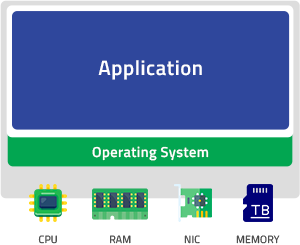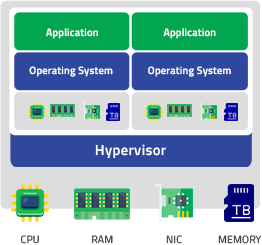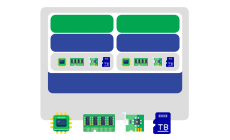| |
Server Virtualization
|
For quite a long time in IT history, many organizations adopted the best practice of deploying one server with one operating system and one application to keep pace with every growing storage and processing demands.
|
| Aside from high operating costs and massive inefficiencies, the software and hardware vendors are requesting the organizations to upgrade their systems for compatibility, when the operating system (such as Windows Server) gets new versions released. Deployment and maintenance of mission-critical systems then is truly a nightmare for IT personnel. They can only execute service maintenance tasks during holidays or odd hours. While unexpected incidents, such as hardware failure, virus attacks, etc., happen, the management and users are eyeing on them for the restoration of service. |
|
| |

| |
What is the
|
Server Virtualization?
|
Server virtualization relies on software to simulate hardware functionality and create a virtual computer system. The virtualization software (commonly known as “hypervisor”) enables IT organizations to run more than one virtual system (widely known as “virtual machine”) – and multiple operating systems and applications – on a single physical server, or “host”.
A virtual machine is a tightly isolated software container that can run its own operating systems and applications as if it were a physical computer. A virtual machine behaves exactly like a physical computer and contains its virtual CPU, RAM, hard disk, and network interface card. The “hypervisor” decouples the virtual machines from the host and dynamically allocates computing resources to each virtual machine as needed. |
|
|
 |
|
 |
 |
| Conventional Computing Infrastructure |
|
Virtualized Computing Infrastructure |
|
|
|
|
| |
Benefits of Server Virtualization
|

 |
|

Hardware Independence
|
- Provision or migrate any virtual machine to any physical server
- Break hardware and software dependency interlock
|
|
|
| |

 |
|

Partitioning
|
- Run multiple operating systems on one physical server
- Divide system resources between virtual machines
|
|
|
| |

 |
|

Isolation
|
- Provide fault and security isolation at the hardware level
- Preserve performance with advanced resource controls
|
|
|
| |

 |
|

Encapsulation
|
- Save the entire state of a virtual machine to files
- Move and copy virtual machines as easily as moving and copying files
|
|
|
| |
|
|
| |
 |
 |
Disaster Recovery
|
| Previously, companies needed to create exact duplicates of their hardware to accommodate disaster recovery. Virtualization eliminates this time-consuming requirement, making it easier to set up an offsite system for this purpose. Disaster recovery or fault tolerance is now made easy. |
|
|
 |
 |
Management
|
| Virtualization technology incorporates monitoring and management tools that let the system administrators either automate tasks or handle them manually, based on usage or threshold alerts. IT personnel can spend their time on incoming producing activities for the company. |
|
|
 |
 |
No Unplanned Downtime
|
| With virtualization, the system can now conduct maintenance without bringing the system down because virtual machines can be moved between servers. The high availability or optional fault tolerance feature can further assure business continuity of mission-critical systems. |
|
|
|


Our Values
|
| We have been helping companies to study, plan, deploy, and enjoy the benefits of server virtualization with our in-house technical team for almost one decade. With specialization in server, network, and system software, our VMware & Microsoft Hyper-V specialists always provide our corporate clients with peace of mind service – be it a new deployment or migration of server farm. Together with server virtualization, we also incorporate backup, replication, and disaster recovery solutions such as Veeam, Veritas, Altaro, and Zerto. |
|
|
|